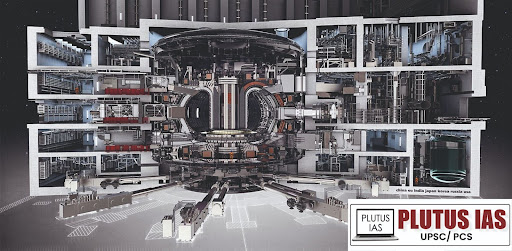14 Feb International Thermonuclear Experimental Reactor (ITER)
This article covers “Daily Current Affairs,” and the topic details related to “International Thermonuclear Experimental Reactor (ITER)”
Syllabus mapping:
GS-3: Science and Technology: Recent development in Nuclear and Energy Technology.
For Prelims:
What is an International Thermonuclear Experimental Reactor (ITER)? What is its purpose? What are the instruments used in the ITER and participating countries?
For Mains:
What are the objectives of the ITER? What is the significance of the ITER? What are the technical and general issues of ITER and its ways to address these issues?
Why in the News?
Prime Minister Narendra Modi and French President Emmanuel Macron jointly visited the International Thermonuclear Experimental Reactor (ITER) in Cadarache, France. This historic visit marks the first time any Head of State or Government has toured ITER, one of the world’s most ambitious fusion energy projects. The visit underscores India and France’s commitment to advancing clean energy technologies, with ITER aiming to demonstrate fusion as a large-scale, carbon-free energy source.

What is ITER?
ITER (originally the International Thermonuclear Experimental Reactor, also meaning “the way” in Latin) is a global nuclear fusion research megaproject aimed at generating energy through fusion, similar to the process occurring in the Sun. It is the world’s largest fusion experiment, being constructed in Cadarache, France.

Brief History of ITER
1985: Concept proposed during the Geneva Superpower Summit.
2006: Seven partners formally agreed to fund and develop ITER.
2013: Construction began at the Cadarache site.
2020: Assembly of the Tokamak reactor started.
2035 (Planned): Expected to achieve first deuterium-deuterium plasma operation.
Participating Countries
ITER is a collaborative effort of seven major members:
China
European Union
India
Japan
Russia
South Korea
United States
Other nations, including Australia, Canada, Kazakhstan, and Thailand, have cooperation agreements.
ITER Participants and Their Contributions
| Country/Region | Contribution |
|---|---|
| China | Contributes superconducting magnets, vacuum vessel components, and other high-tech systems. |
| European Union | Largest financial contributor (~45% of funding), provides Tokamak building, cooling water, and power supply systems. |
| India | Supplies cryostat, cooling systems, and diagnostics. |
| Japan | Provides superconducting cables, neutral beam heating systems, and remote handling technology. |
| Russia | Supplies superconducting cables, gyrotrons for plasma heating, and diagnostic systems. |
| South Korea | Contributes superconducting magnets, vacuum vessel sectors, and power supply systems. |
| United States | Provides Tokamak cooling water systems, central solenoid magnets, and diagnostics. |
| Switzerland | Previously participated through Euratom; currently a non-participant due to EU policy. |
| United Kingdom | Initially part of Fusion for Energy via Euratom; withdrew in 2024 and is no longer a participant. |
| Australia | Not a full member, but has a technical cooperation agreement focusing on plasma research. |
| Kazakhstan | Signed a cooperation agreement in 2017 to contribute to fusion research. |
| Thailand | Joined via cooperation agreement (2018), focusing on knowledge exchange and research support. |
| Canada | Originally a full member but withdrew in 2003; rejoined in 2020 with a focus on tritium research. |
Objectives of ITER
Demonstrate Feasibility of Fusion Power: Prove fusion as a large-scale, carbon-free energy source.
Achieve High Fusion Gain (Q Value): Momentarily produce a plasma with thermal power 10× greater than the injected power (Q = 10). Sustain a steady-state plasma with Q > 5 for extended operation.
Sustain Long Fusion Pulses: Maintain a fusion pulse for up to 8 minutes.
Develop Key Fusion Technologies: Superconducting magnets. Remote handling and robotic maintenance.
Verify Tritium Breeding Concepts: Test methods for producing tritium fuel within the reactor.
Enhance Neutron Shielding & Heat Conversion: Improve technologies for handling energy released by fast neutrons in the fusion reaction.
Experiment with Burning Plasma State: Study self-sustaining fusion reactions for future power plants.
Build Global Fusion Capabilities: Develop skills, tools, supply chains, and project management expertise. Strengthen nuclear fusion industries in participating countries.
The Exact Process at ITER: How It Works
1. Fuel Selection: Deuterium-Tritium Fusion: ITER will use Deuterium (²H) and Tritium (³H), two isotopes of hydrogen, as fuel. Deuterium is extracted from seawater, while Tritium is scarce and will be produced inside the reactor using lithium.
2. Creating Plasma: Heating the Fuel to 150 Million °C:
The reactor uses a Tokamak, a doughnut-shaped magnetic confinement device, to hold the fuel.
Plasma (superheated ionized gas) is created by heating the deuterium-tritium mixture to 150 million degrees Celsius, 10 times hotter than the Sun’s core.
ITER uses three heating methods to reach this extreme temperature:
Ohmic Heating – Using electrical currents inside the plasma.
Neutral Beam Injection – Injecting high-energy neutral atoms into the plasma.
Radio Frequency Heating – Using electromagnetic waves to energise plasma particles.
3. Magnetic Confinement: Containing the Plasma: Since plasma is extremely hot, it cannot touch the reactor walls..Strong superconducting magnets (cryogenically cooled to -269°C) create magnetic fields to confine and shape the plasma in the Tokamak chamber.
4. Fusion Reaction: Energy Generation
Deuterium and Tritium nuclei collide and fuse, forming helium (⁴He) and a high-energy neutron.
The reaction releases 500 MW of heat energy, achieving a fusion gain (Q) of ≥10 (i.e., 10 times the input power).
Helium remains trapped, helping sustain the plasma, while neutrons escape and transfer their energy to the reactor walls.
5. Handling Energy: No Electricity Generation
Unlike commercial power plants, ITER will not convert heat into electricity.
The released energy will be absorbed by the reactor walls and vented to study plasma behaviour.
Future reactors (like DEMO) will use this energy to produce electricity.
6. Tritium Breeding: Future Fuel Self-Sufficiency
ITER will test a breeding blanket, a lithium-based material that captures escaping neutrons to produce Tritium, making future fusion plants self-sufficient.
ITER Instruments and Their Uses
| Instrument | Function/Use in Experiment |
|---|---|
| Vacuum Vessel | Contains plasma using magnetic fields; provides shielding and structural support. |
| Breeder Blanket | Tests tritium production via lithium reactions; contributes to fuel sustainability. |
| Magnet System | Confines and controls plasma using superconducting magnets (central solenoid, toroidal, poloidal, correction coils). |
| Neutral Beam Injectors (HNB) | Heats plasma by injecting high-energy neutral particles (deuterium ions). |
| Ion Cyclotron Resonance Heating (ICRH) | Uses radio waves to heat plasma ions by matching their oscillation frequency. |
| Electron Cyclotron Resonance Heating (ECRH) | Uses electromagnetic radiation to heat plasma electrons. |
| Cryostat | Maintains a super-cool vacuum environment for superconducting magnets and vacuum vessel. |
| Divertor | Removes waste and impurities from plasma, extracts heat, and prevents contamination. |
| Cooling Systems | Maintains operational temperature balance using water, liquid nitrogen, and helium cooling. |

Significance of ITER
Breakthrough in Clean Energy: Aims to demonstrate fusion power as a limitless, carbon-free energy source. Unlike fossil fuels, fusion does not produce greenhouse gases or long-lived radioactive waste.
Scientific and Technological Advancements: Pioneers in plasma physics and fusion energy research. Develops cutting-edge superconducting magnets, tritium breeding, and neutron shielding.
Energy Security & Sustainability: Fusion fuel (deuterium & lithium for tritium) is abundant and widely available. Reduces dependence on finite fossil fuels and nuclear fission.
Global Collaboration: Largest international scientific collaboration in energy research. It involves seven major partners: the EU, the USA, China, India, Japan, Russia, and South Korea.
Economic & Industrial Impact: Boosts high-tech industries, supply chains, and job creation in participating countries. Strengthens expertise in engineering, robotics, and large-scale project management.
Lays Foundation for Future Fusion Reactors: ITER is a stepping stone for commercial fusion power plants like DEMO. Helps refine reactor designs for sustainable power generation in the future.
Advancing Fundamental Physics: Enhances understanding of plasma behavior, magnetism, and extreme heat conditions. Supports broader applications in space science, astrophysics, and material sciences.
Present Status of ITER
The reactor will not generate electricity but aims to demonstrate the feasibility of nuclear fusion as an energy source.
It seeks to produce 500 MW of fusion power while consuming only 50 MW, achieving a Q-value (fusion gain) of ≥10.
Construction delays and rising costs have led to budget estimates between €18-22 billion (some estimates suggest $45-65 billion).
Current Timeline:
First hydrogen plasma achieved: Work is 70% complete (as of mid-2020).
Full deuterium-tritium operations planned for 2035.
ITER’s successor, DEMO, aims to be the first fusion reactor to generate electricity experimentally.
Issues with ITER and Ways to Address Them
| Challenges | Ways to Address | Steps Taken |
|---|---|---|
| Plasma Stability & Control | Advanced Magnetic Confinement – 18 powerful toroidal field magnets. – Active feedback control systems. – Pellet injection & magnetic perturbations. |
Plasma control experiments in JET & EAST. |
| Material Durability | Radiation-Resistant Materials – Tungsten-based divertors. – EUROFER steel for neutron resistance. |
ITER testing breeder blankets. |
| Tritium Fuel Supply | Breeding Tritium In-Situ – Lithium-based breeder blankets. – Tritium-sharing agreements. |
Canada joined ITER (2020) for tritium expertise. |
| Superconducting Magnet Performance | High-Performance Superconductors – Nb₃Sn for toroidal coils, NbTi for poloidal coils. – Quench detection systems. |
Successfully tested 40kA superconducting cables. |
| Vacuum Vessel & Heat Management | Efficient Cooling & Shielding – Helium-cooled blankets. – Advanced heat exchangers & liquid nitrogen cooling. |
ITER cryostat completed in 2020. |
| Remote Handling & Maintenance | Robotic & AI-Driven Maintenance – Autonomous robots & manipulators. – AI-powered reactor monitoring. |
Built Remote Handling Test Facility in France. |
| Energy Gain & Continuous Operation | Optimized Plasma Heating & Fueling – Neutral beam injection, radio-frequency heating, electron cyclotron resonance. – Extended tokamak pulse length. |
EAST tokamak achieved 1,056s sustained fusion (2023). |
| High Costs & Funding Issues | Global Cost-Sharing Model – International contributions (money, manpower, technology). – Public-private partnerships. |
ITER Council ensures budget & financial stability. |
| International Collaboration & Politics | Independent Governance & Dispute Resolution – ITER Council neutral decision-making. – Bilateral agreements. |
UK remains in fusion research despite Brexit (2024). |
| Construction & Engineering Complexity | Modular Assembly & Precision Manufacturing – Pre-fabricated components. – Digital twin technology for simulations. |
70% of ITER components built & delivered. |
| Public Perception & Regulatory Hurdles | Transparent Communication & Safety Protocols – Open research publications. – Public education & outreach programs. |
Fusion Education Programs launched globally. |
| Competition from Alternative Energy | Faster Development & Industry Partnerships – Collaborating with private fusion startups. – Exploring hybrid fusion-fission reactors. |
First private-public fusion projects started in EU & US. |
Conclusion
ITER is tackling technical & logistical challenges with cutting-edge solutions and global partnerships. Progress in plasma control, materials science, tritium breeding, and superconducting magnets is ensuring fusion’s viability. Despite hurdles, ITER remains the world’s most ambitious fusion experiment, paving the way for commercial fusion power.
Download Plutus IAS Current Affairs (Eng) 14th Feb 2025
Prelims question
Q. Which of the following is the primary objective of ITER?
(a) To develop nuclear fission technology
(b) To demonstrate the feasibility of fusion power as a large-scale energy source
(c) To produce electricity for commercial use
(d) To replace all existing power plants immediately
Answer: (b)
Mains question
Q. Discuss the key objectives of the ITER project and how they contribute to the future of fusion energy.
(Answer in 150 words)




No Comments